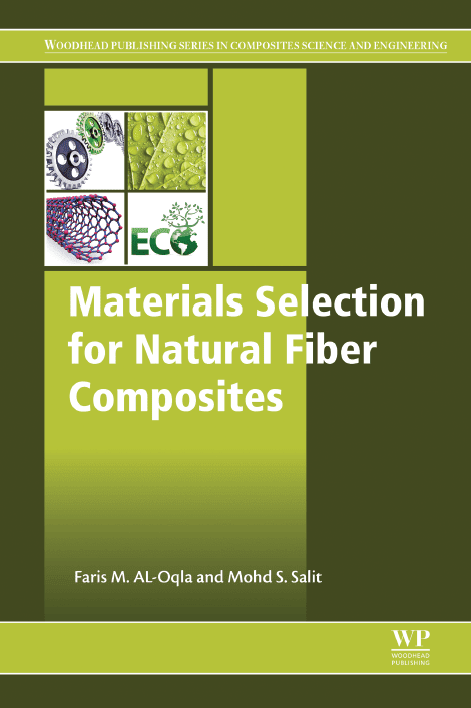
Contents
Preface vii
1 Introduction 1
1.1 Background 1
1.2 Materials and design 2
1.3 Composite materials 5
1.4 Materials selection 8
1.5 About this book 14
References 18
Further Reading 21
2 Natural fiber composites 23
2.1 Natural fibers 23
2.2 Advantages and disadvantages of natural fiber composites 28
2.3 Mechanical properties of natural fiber composites 35
2.4 Other properties of natural fiber composites 37
2.5 Applications of natural fiber composites 37
2.6 Challenges in developing natural fiber composites for wide
industrial applications 44
References 45
3 Materials selection 49
3.1 Materials selection and design 49
3.2 The needs for materials selection 50
3.3 Tools and techniques of material selection 53
3.4 Conventional materials selection techniques 55
3.5 Ashby charts 57
3.6 Advanced materials selection techniques 60
References 68
4 Material selection for composites 73
4.1 Various issues in materials selection in composites 73
4.2 Selection of matrices 76
4.3 Selection of fibers 82
4.4 Research work on materials selection for composites 89
4.5 Advanced techniques in composite materials selection 91
References 100
5 Material selection of natural fiber composites 107
5.1 The need for materials selection of natural fiber composites 107
5.2 Traditional approaches 109
5.3 Proper assessment of natural fibers capabilities 113
5.4 Evaluating polymer matrices for natural fibers 124
5.5 Predicting the potential of new fiber types for industrial applications 128
5.6 Issues and challenges 149
References 162
Further Reading 168
6 Material selection of natural fiber composites using the analytical
hierarchy process 169
6.1 Background of analytical hierarchy process 169
6.2 Appropriateness of analytical hierarchy process for natural fiber
composite selection 172
6.3 Pairwise comparison under uncertainty environment for bio-based
materials 176
6.4 Selecting natural fibers for a particular application under
conflicting criteria using analytical hierarchy process 179
6.5 Selecting polymers for bio-based materials under conflicting
criteria using analytical hierarchy process 187
6.6 Evaluating various natural fiber composites under conflicting
criteria using analytical hierarchy process 200
6.7 Optimizing the reinforcement conditions of natural fiber
composites using analytical hierarchy process 212
6.8 Sensitivity analysis of the selection models using analytical
hierarchy process 223
References 228
Further Reading 234
7 Material selection of natural fiber composites using other methods 235
7.1 Java-based materials selection 235
7.2 Knowledge-based system 241
7.3 Digital logic technique 244
7.4 Quality function deployment for environment 246
7.5 Pugh selection method 253
7.6 Artificial neural network 255
7.7 TOPSIS method 261
References 267
Index 273
Preface
Alhamdulillah, all praises to Almighty Allah who has enabled us to complete writing of the book titled Materials Selection for Natural Fiber Composites. The book is based on our long and solid experience with the topic. Books about natural fiber composites have, in fact, been published, but the emphasis has been mainly on the characterization and performance of such materials. It was noticed that there was the real need to write a book on material selection for natural fiber composites, as no book (either edited or authored) is found in the market dealing with this subject, let alone for natural fiber composites. Therefore, we strongly believe, the readers will greatly benefit from this book, as the majority of the materials contained therein are considered new to the research community.
This book is the first systematic effort toward developing a better understanding of material selection for natural fiber composites. In this book, we’ve put a lot of emphasis on the use of material-selection tools, particularly the Analytical Hierarchy Process (AHP), a simple and yet very powerful tool in solving different issues in material selection for natural fiber composites, along with other established tools and techniques that can be implemented in natural fiber composite selection to expand the sustainable design possibilities, as well as to support the cleaner production needs for the future.
The focus of this book is on natural fiber composites only—even though a book on the material selection of composite materials itself is still missing. This is because we have been dealing most, specifically, with natural fiber composites for more than15 years, and we felt, our contribution to this part of the topic was much greater and more information that was based on our own experiences in dealing with natural materials could be shared. Indeed, natural fiber composites, in the recent years, have become important materials used in different industries such as automotive, aerospace, defence, medical, furniture, and the building and construction industries, and the need for developing tools and techniques of material selection for such materials has become more apparent. In consequence, this book is filling a gap, documenting the latest research and developments, as well as providing a better understanding for a bio-based material selection system for various industrial applications with various conflicting criteria, as we have successfully introduced and established new methodologies for enhancing the selection of natural fiber composites and their constituents for sustainable industries, as well as having established new assessment methods for the material selection process in this field.
Furthermore, this book is sufficiently important to support advancements in recent knowledge about natural fiber composite material selection, because without this book, researchers will have difficulty obtaining a step-by-step approach for this process. This does not mean the reader will be given a tool like software to help them with material selection, but this book can help and guide the reader to perform material selection for bio-based materials in uncertain environments, with simultaneous conflicting criteria and parameters, to achieve successful, low-cost, eco-friendly products, as well as satisfying both technical and customer satisfaction attributes in a fairly optimized manner.
In dealing with natural fiber composites, we are more concerned with material selection criteria such as strength, stiffness, low cost, lightweight, availability, renewability, recyclability, biodegradability, and environmental friendliness. Most of these criteria are unique to natural fiber composites and therefore many industries are very serious about adopting these materials for their products. We are hopeful that this book will become a good guide for those who are dealing with material selection, and with design and product development from natural fiber composites.
